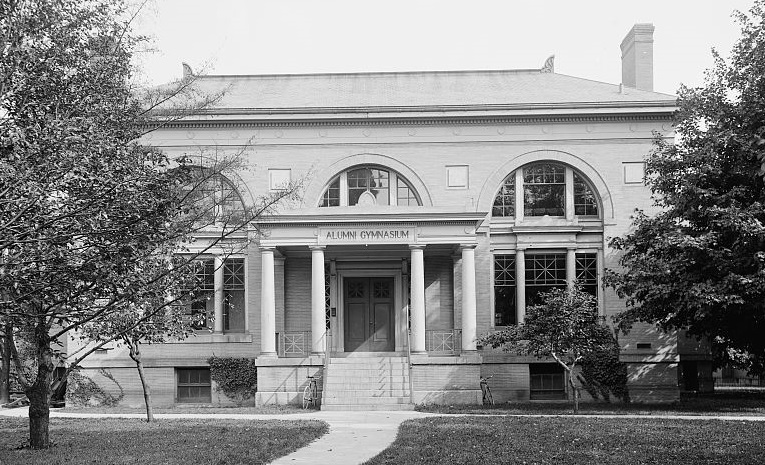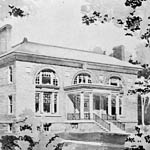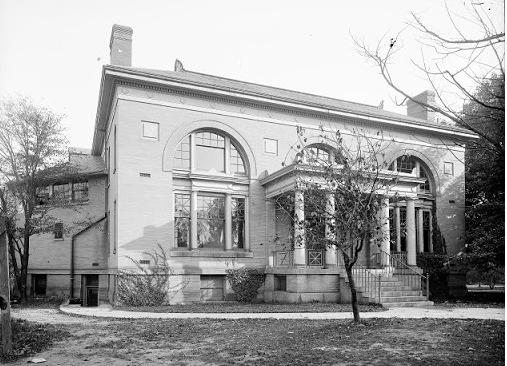
| Prince Street Campus | Alumni Gym |
 |
| 1904 Alumni Gymnasium, from Library of Congress |
| Pictures of Alumni Gymnasium | |
 |
 |
The Alumni Gymnasium was funded through Alumni subscriptions and opened on June 11, 1900. The building was demolished in 1932 to allow room for construction of Cutler Union.
References
1900 Interpres,
Class of 1901
Pages 60-62: The Gymnasium, including floor plans
1900 Fifty-First
Annual Catalogue of the University of Rochester
Pages 23-25: The Alumni Gymnasium with floor plans
1910 The
University of Rochester : buildings and grounds
Pages 19-20: Alumni Gymnasium
1927 Rochester,
the making of a university, by Jesse Leonard Rosenberger, with
an introduction by President Rush Rhees.
Page 235: The need of a gymnasium was from time to time urged, by
the undergraduates in particular. The alumni appeared to be less generally
concerned about it; but it was reported that at the alumni dinner in 1890
two of the alumni pledged $2,000 toward a gymnasium. That was about as far
as the matter got for some years to come, although the agitation for a
gymnasium was renewed at times, with increasing insistency. Meanwhile the
catalogue stated that an arrangement had been made whereby students in the
university might, by the payment of a nominal fee, enjoy all the
privileges of the new building of the Young Menís Christian Association,
which building contained a completely equipped gymnasium.
Page 261: It was a source of gratification that the efforts of the
alumni to provide a gymnasium had been so far successful that the
completion of the building might be expected within the coming year.
In his report dated May 25, 1900, Acting President Burton said with regard
to the gymnasium that it would be used as an assembly hall during
commencement week and that at the beginning of the fall term it would be
fully equipped and ready for daily use. Its completion was a significant
event as introducing into the life of the college the new and valuable
element of physical training, with all the incidental benefits that it
brings; but it was still more significant as a proof of the interest felt
by the alumni in the college. The gymnasium was the gift, not of one man,
nor of a few men, but of hundreds of former students, who remembered their
alma mater with gratitude and were not unmindful of her needs. [It cost
something over $22,000.]
1977 History
of the University of Rochester, by Arthur J. May (on-line
version with footnotes)
Chapter 11, Hill and the Interregnum
In 1897 an alumni committee appealed to graduates to subscribe a minimum
of $25,000 and inspected gymnasiums at New England colleges to pick up
ideas. The Interpres of 1898, "hopefully dedicated to the
Alumni Gymnasium Committee," carried an architect's rendering of the
proposed structure and reiterated that the U. of R. was the "only
important college in the east without appliances for the needed physical
culture of students." "With the student body, the millennium is the
erection of a 'gym,' " it was remarked. Subscriptions came in very slowly,
but in 1899 enough money was in sight to move ahead with construction
plans, and it was decided to place the building on the southeast corner of
the college park adjacent to the playing fields.
Designed by a Rochester architect, J. Foster Warner, the gymnasium was
built of gray brick, trimmed with light colored stone; three arches and an
entrance porch formed the facade. As shown on diagrams printed in the 1900
Interpres, on the first floor there were a reception or trophy
room, offices of the athletic director, and the main hall, ninety-four
feet long, fifty-three feet wide, and twenty-five feet high; appliances
for exercise conformed to those available in any well-equipped gymnasium
of the time. On the second floor an elliptical running track with
twenty-four laps to the mile could accommodate, when needed, spectators
watching activities in the main hall below; toilet and dressing rooms,
quarters for the Campus and student organizations, and a
capacious well-lighted reading room were provided. Baths, a small tank for
a quick plunge, a bicycle room, a bowling alley, a handball cage, lockers,
a boiler room and bins to store coal occupied the basement. Building and
equipment cost rather more than $28,000 of which contributions from some
300 alumni exceeded $16,000.
Formally opened in 1900, the Alumni Gymnasium stood for only a little more
than thirty years, or just about as long as the agitation for it had been
underway. Reversing the posture of President Anderson, Hill urged that
dormitories should be provided, but instead a set of fraternity chapter
houses, noted in the next chapter, was constructed.
© 2021 Morris A. Pierce